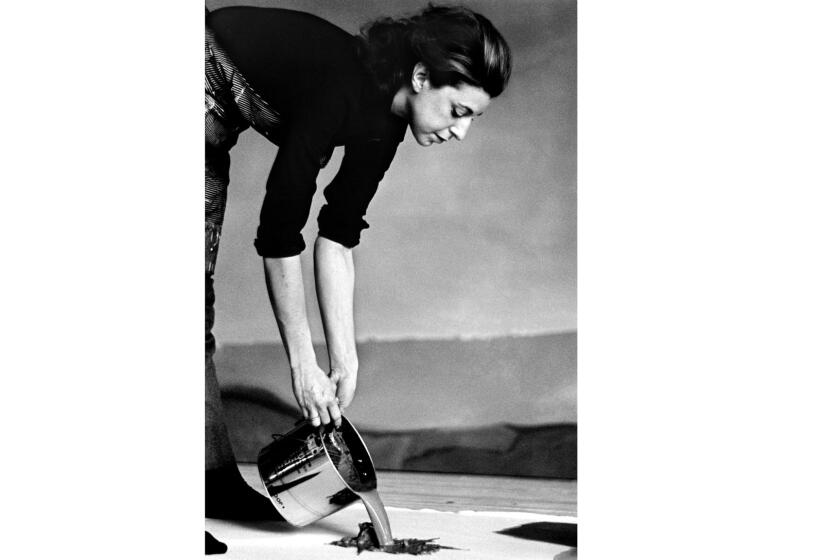Searing letter demands a halt to the sale of Baltimore Museum of Art paintings
- Share via
A group of 23 prominent supporters of the Baltimore Museum of Art, including former trustees at the BMA and the nearby Walters Art Museum, has written to Maryland Atty. Gen. Brian Frosh and Secretary of State John C. Wobensmith to demand that they intervene to stop the impending sale of paintings from the storied museum’s collection.
In a blistering and closely argued six-page letter, the opponents describe the plan as being peppered with potential conflicts of interest and procedural irregularities. Many reflect upon financial issues, asserting that “the BMA did not sufficiently exercise its fiduciary duty in valuation of the work and seeking competition to maximize the sale proceeds.”
The letter further charges that the private sale of Andy Warhol’s monumental painting “The Last Supper,” acquired for the museum’s permanent collection more than 30 years ago, “is likely being sold, or already has been sold, at a bargain-basement price.”
Warhol’s 1986 canvas is believed to have been guaranteed for $40 million in a private sale through Sotheby’s auction house. A comparable Warhol painting from the same series sold at a Christie’s auction in 2017 for more than $60 million.
As part of an alarming trend, a museum is selling a 1946 Jackson Pollock drip painting to raise money to diversify its collection. Good intention, bad plan.
A firestorm erupted this month when BMA Director Christopher Bedford announced that upward of $73 million in contemporary art from the permanent collection would be liquidated to create an endowment to boost salary and benefits for museum employees, as well as to buy supplies needed to store and care for the remainder of the museum’s collection.
The plan includes purchasing additional art from a $10-million fund to be set aside from the sale. The BMA collection numbers some 95,000 works of art, including what is reputed to be the largest holding of works by Henri Matisse in the world.
The letter was prepared by Laurence J. Eisenstein, a Washington, D.C., attorney and former BMA trustee who once served as chairman of the committee that acquires art for the institution. Signatories include former BMA board Chairwoman Constance R. Caplan, as well as five past members of the museum’s contemporary art acquisitions committee.
The letter further claims that curatorial staff members at the museum voted to approve the art’s sale, even as they stood to gain from the salary and benefits increases envisioned in the plan. Bedford, the museum’s director, “placed the curatorial staff in an untenable position where they could not avoid the appearance of a conflict of interest,” the opponents charge.
Former trustees and other supporters of the Baltimore Museum of Art have asked Maryland officials to intervene in the sale of paintings from the permanent collection
“We understand that the unanimous curatorial support reported by the BMA for [the sale] was critical to several of the accession committee members and trustees who subsequently gave their vote to approve deaccessioning,” the letter states.
Deaccessioning is the term for formal removal of a work of art from a museum’s permanent collection.
A museum spokeswoman said the museum had not received a copy of the letter. [On Thursday afternoon the museum issued a statement denying any legal problems with the sales.]
The Baltimore Museum of Art issued a statement denying any “legal issues” related to the impending sale of paintings from the collection.
Heading for the auction block at Sotheby’s at the end of the month are Clyfford Still’s “1957-G,” a wall of craggy color by the important Abstract Expressionist painter, and “3,” a sinuous 1987 abstraction by Minimalist Brice Marden.
Still lived and worked in Maryland for nearly 20 years before his 1980 death at the age of 75, donating the painting to his local art museum in 1969. Marden is 82 and works in New York; it is highly unusual for a museum to sell off art by a living artist. Warhol died in 1987 following emergency gallbladder surgery.
A monumental Helen Frankenthaler painting, an anchor in the collection for a quarter-century, appears poised for the salesroom.
More to Read
The biggest entertainment stories
Get our big stories about Hollywood, film, television, music, arts, culture and more right in your inbox as soon as they publish.
You may occasionally receive promotional content from the Los Angeles Times.












